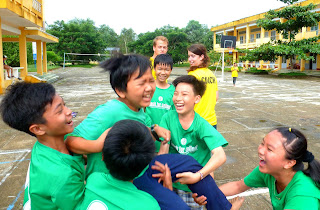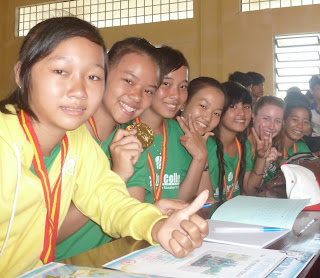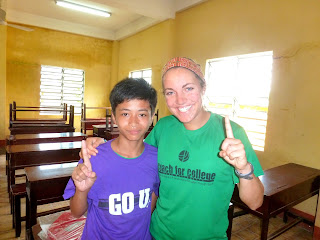 |
| #7!! |
The remainder of our Cambodian journey in Phnom Penh (minus the museum, which I will describe later), brought all three of us to memories of Can Tho, Vietnam, especially because of the river passing through. Because we wandered by the Royal Palace all the time, we were constantly having to avoid (or join in) huge parades and gatherings for the political candidate and incumbent #4 (Hun Sen, the authoritarian leader). Outside the Royal Palace in Phnom Penh was the only place we ever ran into supporters of #4. The #7 crowds were a lot rowdier and favored by all of our tuk-tuk drivers and hotel service people and street food vendors. The Khmer people thought it was hilarious when we cheered for their political candidate (only #7, in my case).
Riot police were in all the crowded parks, just watching and waiting. We were woken up by parades at 6:45 am, and kept awake late into the night by excited #7 supporters. Apparently, tourists were told to get out of Phnom Penh for their own safety on Sunday (we left on Friday morning so this was not an issue for us). I never felt worried, only welcomed by each party.
**update** Apparently, #4 won the election, but not without some fishy election rigging. It was the biggest election in 20 years!
-------------------------------------------------------------
We ended a boiling hot day of touring the Royal Palace (including the amazing traditional outfits worn by the monarchy and staff) and plenty of wats with a visit to the Toul-Sleng Genocide Museum at the prison complex S-21. The prison was used to hold and torture political prisoners by the Khmer Rouge between 1975 and 1979. The Khmer Rouge (AKA Angkar) converted a high school to a prison, forgoing all of the architectural prowess of their ancestors from the Khmer Empire in favor of netted barbed wire and hasty 0.8 x 2 m brick cells in the class rooms. They used the school exercise equipment as torture devices, in addition to many other modern and ancient methods of torture including starvation, electrical lashes, and far more gruesome acts of hatred.
In this prison, the Khmer Rouge killed approximately 10 to 30 people every day, usually by driving an hour out to the killing fields and beating them or slitting their throat. I read that a total of up to 20,000 prisoners were killed in those 4 years, including children (the total regime killed somewhere around 2 million people). There seemed to be little rhyme or reason as to who stayed to be tortured and who was executed, because all were forced to confess to the exact charge of treason demanded by the Khmer Rouge. Most charges had to do with being associated with Vietnam, the CIA, or the revolution.
The city of Phnom Penh was deserted during the reign of the Khmer Rouge except for party officials, because non-party members were evacuated to the country side to work essentially as slave laborers to produce food for the regime. The people were fed very little. Most of the food they grew was exported. In pictures, it is clear to tell the party officials from the non-officials, not only from their all black dress and Khmer scarves and caps, but because the officials were fairly plump and stilll strong in comparison to the weak and very thin, starving majority.
I had heard of the Khmer Rouge and Pol Pot, but I did not know much about the details and I honestly would have had some difficulty pointing to Cambodia on a map. Being here makes all of that history become so much more real. The Khmer Rouge was in power during my parents' adult lifetime, and they existed through my own life, until they were officially dissolved in 1999. I realized that I had met people much older than me who must have survived this regime, and many more who were directly or indirectly affected by the regime or the immediate repercussions. Pol Pot died in 1998 but the other masterminds behind the Khmer Rouge are still waiting to be tried in court, with the help of defense lawyers form America and Europe. It is unbelievable to me that a lawyer could have such a lack of moral compass to stand in front of the entire world and defend the instigator of a four year long genocide.
One of the most heart wrenching sights I saw was in the first two prison cells, where hundreds of mug shots of the prisoners/victims covered the walls. I was surprised to see at least ten or so elderly Cambodians, wearing khmer scarves (everyone wore these scarves at the time, not just the Khmer Rouge members) and looking slowly and carefully at each picture. It looked like they were searching, and would sometimes stop and point at one of the grim faces. Many faces were anguished men, women, and children, many looked confused and disoriented. I imagine that the elderly Cambodians were looking for signs of friends and family, and my stomach sank when I realized that was a very distinct possibility. Its insane and sobering to realize that such a genocide can occur at all, and especially so recently.
I tend to feel some sort of superiority when looking back at terrible historic events, thinking that those people must have been so ignorant, and we have learned now and would never let something like that happen. But first of all, who is we? And clearly "we" have not learned enough. Terrible inhumane catastrophes still happen and ARE still happening! I have seen so many different torture devices since visiting South East Asia ( including some used by the American military), and I know that torture is still present, even with prisoners of America (i.e. Guantanamo Bay). Though hidden, its not so secret. How can we turn a blind eye?




































